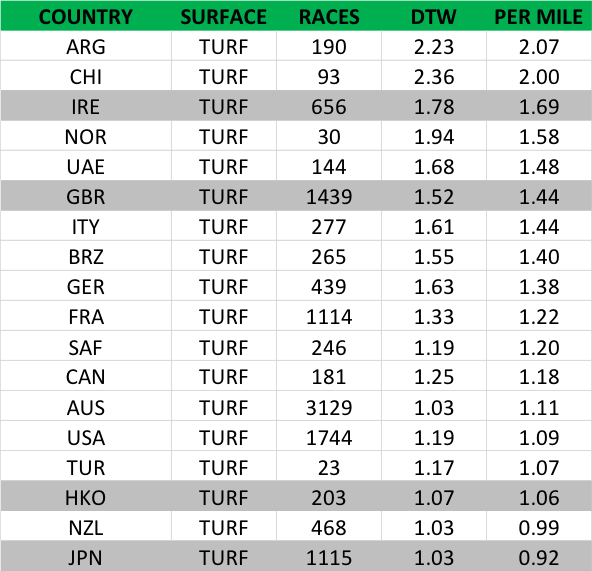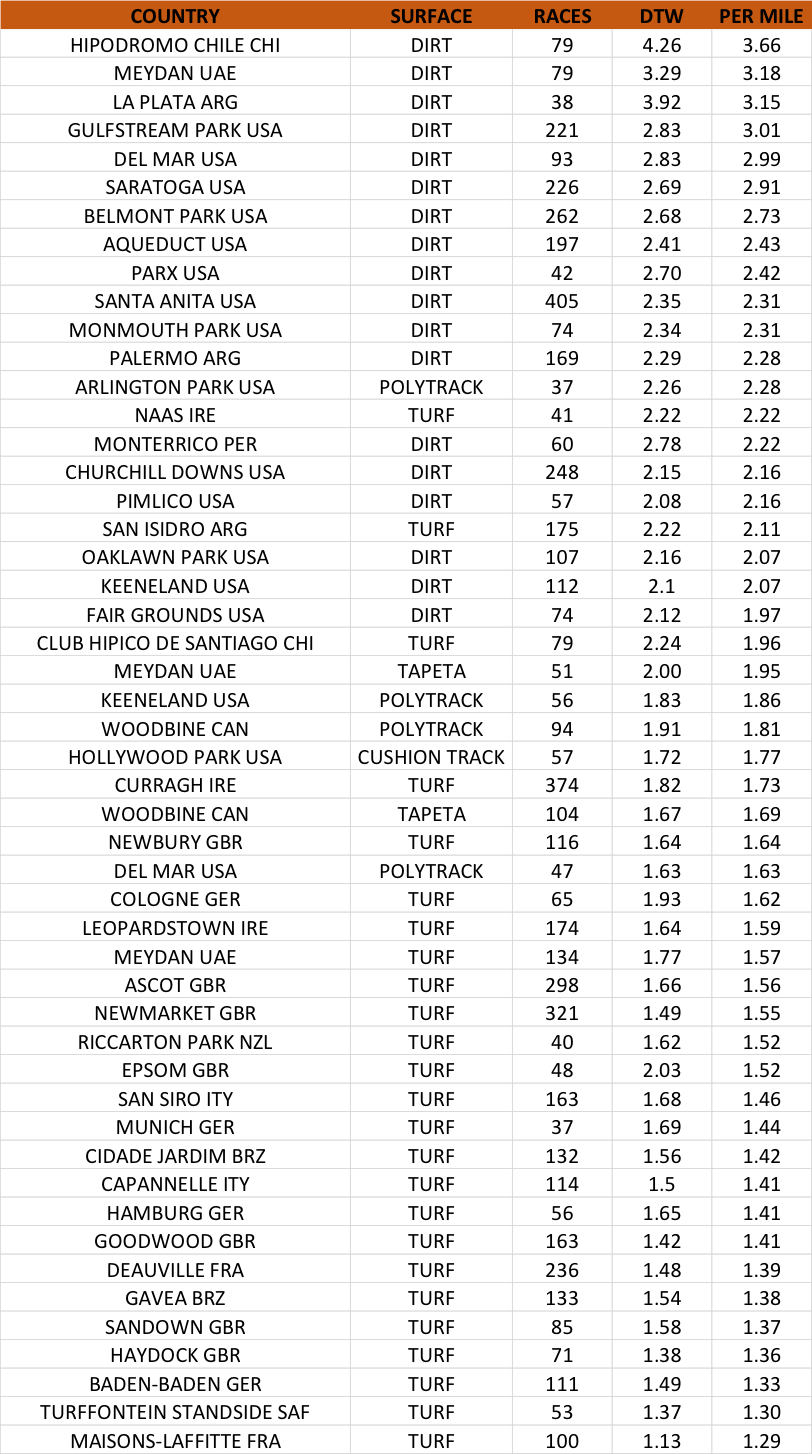
TRC Global Rankings has determined by computer that Almond Eye, the Japanese super mare, deserved the highest ranking in the world among horses who raced in 2021. Yet she only just scrapes into the top ten according to this week’s Longines World’s Best Racehorse Rankings (WBRR), which were unveiled on Tuesday. How can this be?
Firstly, it’s not because the handicappers who make up the WBRR committee are inexpert. Far from it. They execute the system of collateral form ratings with integrity, effort and no lack of advanced understanding.
It’s not the handicappers who are wrong. It is the system. According to the way we look at things, the WBRR is biased towards countries where the winning margins of races tend to be wider and to horses who make the running under those conditions.
Both these factors count against Almond Eye and Golden Sixty - the two most brilliant Thoroughbreds of a strong collection who raced in the Far East in 2020. In countries like Japan and Hong Kong, the ground is often very fast and margins between finishers are much reduced compared with the big, galloping tracks of Europe where cut in the ground is common and a good pace often sorts the field out. Fields are even more strung out by dirt racing in the U.S, but the opposite effect is observed on turf there.
In the period 2003-2020, there have been 23 horses top-rated or joint top-rated in the WBRR. Only one of these was Japanese, Just A Way (130) in 2014. And it is hugely instructive to note the country in which his best rating was earned – for it wasn’t Japan. It was, in fact, Dubai where – with no lack of irony – he benefitted from a strong pace to sweep through from the rear to win the G1 Dubai Duty Free at Meydan by more than six lengths.
Just A Way wasn’t a great Japanese Thoroughbred. Sure, he was a G1 winner at home, but he lost no fewer than 16 Group races. What he did have was the chance to show his full superiority over a field that included some very smart European horses.
Almond Eye won the same race as Just A Way in 2019. She didn’t have the same strong pace, but it did not stop her and – as is typical – she quickened smartly from midfield and had tons more in hand than a length and a quarter over Vivlos, with half a length back to Lord Glitters. The placed horses are G1 winners, but they are just good, solid G1 winners. Almond Eye is a super G1 winner.
In the latest season, Almond Eye took her total of G1 wins to nine – yes, nine – back on home soil. She won three out of four at the highest level, spanning the distance range from eight to 12 furlongs. Summarising her career, the Racing Post’s Scott Burton wrote an excellent piece (Brilliant star of the east: why Almond Eye is the equal of Treve and Enable) in which he said,
“In an era of superstar fillies and mares, Almond Eye has carved a unique place for herself in 21st century racing history, one which stretches far beyond her staggering career earnings.
“Almond Eye must surely be considered at least the equal of Treve and Enable.”
Place in racing history
Burton is dead-on, at least according to TRC Global Rankings. This is exactly why our algorithm tagged her as world #1 for 2020. However, while the European-trained Treve (2013) and Enable (2019) received proper recognition of their brilliance by heading the WBRR, Almond Eye is merely in a tie for tenth.
This is clearly wrong. Her form is absolutely rock-solid. Almond Eye is a superstar and a champion and was very hard to beat on the big days. And she deserves to be rated as such by racing history – not relegated so noticeably, as if she were a fraud.
Any club of top horses that doesn’t include her is not a club worth being a member of.
In the Japan Cup, Almond Eye defeated the two Japanese Triple Crown winners Contrail and Daring Tact – the former unbeaten to that point. Prior to that, she tagged Fierement and Chrono Genesis in the G1 Tenno Sho (Autumn). Her only loss came over a mile to the tip-top Gran Alegria who went on to win the G1 Sprinters Stakes and the G1 Mile Championship.
The problem is that the margins are compacted by the nature of Japanese racing, which rarely stages races expansive enough to allow a horse to rack up the ratings points needed to get to the top of the WBRR. It can happen, of course, as when Epiphaneia (129) beat Just A Way by four lengths in the 2014 Japan Cup. As this came subsequent to the latter's Dubai romp, Epiphaneia himself earned a big figure and finished second in the WBRR classification. But to argue from this result that Japanese horses are not at a systematic disadvantage from pace and conditions frequently compacting the field would be contrary, as the STATISTICAL APPENDIX of this article proves.
When the ground is not rock hard, the best Japanese horses just open up and fly away: Chrono Genesis won by six lengths and five when the ground was softer than usual for the country in the G1 Takarazuk Kinen at Hanshin, for example.
Maxing out
If all Japanese racing took place under similar conditions, the WBRR would surely look different. Witness the ten-length demolition of the G1 Prix d’Ispahan field by A Shin Hikari on heavy going at Chantilly in 2016. What is needed is for the exchange of lengths for ratings points to be slightly expanded on firm going in Japan and the entire ranking of horses in the WBRR would change to more accurately reflect the quality of these Thoroughbreds. With the rare Japanese race that breaks down and does yield wide margins, all that is need is to treat it conservatively. This is merely an application of good sense.
In short, a more fluid approach is needed to translating distances to rating points, one which takes into account the track, the surface and the pace. It seems odd that some consider this subjective, when the very process of handicapping involves a degree of interpretation. A handicapper isn't forced to always take wide-margin winners at face value, after all. What handicapping should establish is an order of merit, one in which the quality of horses beaten - and, crucially, the frequency with which it is achieved - is evident in the numbers.
When inflexible computation forces counterintuitive results on intelligent followers of the sport, it is for the compilers of the system to consider if there are variables missing from the algorithm. We live in a world now where people don't take the judgments of experts at face value when they are able to interrogate the data for themselves, or merely when they have access to all the evidence and trust their own cognitive abilities which are battle-tested in other walks of life.
Ghaiyyath, who was named the highest-rated horse in the world, is a formidable galloper, but he typifies the kind of animal who maxes out his rating score under the WBRR framework. He makes the running on galloping tracks and breaks the opposition when he wins, just like A Shin Hikari did.
This is no diminution of Ghaiyyath. What he does is for real and he deserves the plaudits of a top-class horse. But, so does Almond Eye, and the gap between them of 6lb is mostly consumed by Almond Eye racing with a fillies’ allowance of 5lb in Japan.
This, in effect, is subtracted from her ratings. This needs to be added back in to compare her with males because there is no sense naming another horse the world champion if your figures show it wouldn’t beat a lower-rated female runner in a championship race. Clearly, it is imperative to either discard the allowance in competition or add it back to the ratings of females in classifications. Horses of both sexes are ridden with the same broad tactics on average – females are not extended more, especially in Japan.
All it needs for Almond Eye to be rated the top horse in the world as her record dictates is for alowances to be added back in to ratings and the scale of ratings-points-for-lengths to be expanded in line with the data, so that the horses Almond Eye beat were themselves rated higher and her margin of victory in lengths translated to a higher total in ratings points. TRC Global Rankings does this, and also adds back in fillies’ allowances, allowing a true championship order to emerge.
Let’s repeat this: There is nothing much wrong with the WBRR that the above tweaks cannot easily repair. It’s just illogical taking so much effort to produce a classification in which a legendary Japanese runner is rated lower than the British-trained 3-year-old Palace Pier just because he got to race in a strongly-run race in the mud, or the sprinter Classique Legend, who hasn’t even won a race on the list of G1s ratified by the International Federation of Horseracing Authorities (IFHA), which oversees the WBRR, and racked up a massive figure from miles behind when the field went off too fast in the Everest at Randwick.
This, and many other unflattering comparisons with Far East runners over the years, is undermining the great work done by the handicappers.
The handicappers themselves must know the system is unsatisfactory and it really doesn’t need much to make it right.
STATISTICAL APPENDIX
When making ratings, it is crucial to use a very different conversion rate from lengths to rating points. TRC Global Rankings does this, which neutralises the differences between countries, courses and surfaces, and results in the top Far Eastern horses, like Almond Eye and Golden Sixty, being ranked higher than Ghaiyyath.
Here is a table of the average winning distance for each country in races on turf since 2011:

Japan is stone-cold last among all major countries because conditions are so firm and the racing incredibly tight. This is also true of Hong Kong, where the brilliant Golden Sixty races.
The ratio between winning distances between Great Britain and Japan is 1.57 lengths per mile. So, if a handicapper uses 2 points per length in a race over a mile in Britain, then something like 3 points per length should be used in Japan. (Technically speaking here, differences in lengths come from differences in finishing times, so it is better to use and talk about seconds per minute rather than lengths per mile.)
It is important to recognise that, to a lesser extent than conditions, the distribution of talent in each country also results in the spread of horses at the finish. We consider that a relatively minor effect compared with conditions, however, because spread is only weakly correlated with quality.
Countries associated with the best racehorses appear at either end of the table above, for instance.
The field tends to finish much more strung out on dirt. Here is the equivalent chart:

In both tables above, we have included only countries where more than 20 races appear on the TRC database covering the period from 2011, which is currently at 15,464 races involving 156,042 runners. Incidentally, cleaning and standardising this data is not a straightforward task and we are indebted to the Racing Post for the bulk of it.
As well as differences by country, there are differences by course. TRC uses this data too, though it is regressed towards the country-specific data according to the sample size:




